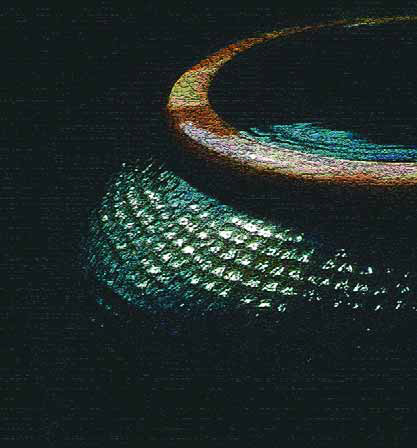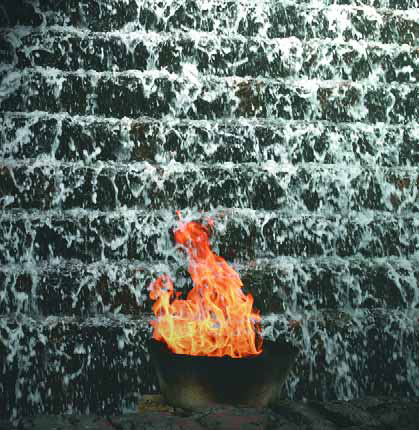A tremendous amount of synergy and teamwork went into the making of "The Ultimate Family Home." Initiated by Builder magazine (the official publication of the National Association of Home Builders) and Pardee Homes (the Los Angeles-based developer of the Nevada Trails neighborhood in which the home was built), the project unfolded as a partnership between the magazine and the developer's Las Vegas office along with Bassenian-Lagoni Architects (Newport Beach, Calif.), Color Design Art (Los Angeles) and Lifescapes International (the Newport Beach-based landscape-architecture firm). "The Ultimate Family Home" opened in January 2004 in conjunction with
I don't know who first expressed it, but I've always welcomed the notion that "great designers are great thieves." That nugget rings so true because very few among us ever have completely original ideas and, in fact, the best designs are generally derivative of something that came before. To my mind, if some degree of larceny is part of our game as watershape designers, then one of the very best places to find borrowable ideas is a book entitled The Annotated Arch by the historian Carol Strickland (Andrews McMeel Publishing, 2001) - a wonderful and inspiring 180-page, beautifully illustrated book that offers a
It's unusual to think of such a wonderfully decorative watershape in this way, but the one featured in this edition of "Details" was the result of a client's desire for a measure of safety for the front of his home. The house is located on an intersection in a hilly part of Manhattan Beach, Calif., where the steep, downhill orientation of the streets occasionally lead cars to make turns at unwisely high speeds. Given the orientation of his front door, my client was concerned that, with a bit of very bad luck, he might someday find an out-of-control-driver's car in his foyer. As is the case with many
In preparation for creating plant palettes for my projects, I typically spend hours poring over my Sunset Western Garden book. I thrive on finding plants I haven't tried before, and I look especially for those I haven't seen in anyone's garden. Before I'll try any of these discoveries out on someone else, however, I'll pick up a sample plant and bring it home to my own garden - part science project, part proving ground to see how the plants perform away from the nursery. I've had many successes through the years and probably as many failures, but I learn something from every attempt. What I sometimes find are plants that are
As watershape designs become ever more creative and adventurous, there's an increased need to help clients and other project participants visualize our plans. Indeed, presentation is a topic of great importance these days for designers from both the pool/spa industry and the landscape trades, so much so that it's become a fixture on educational calendars and one of the cornerstones of the Genesis 3 curriculum. What has everyone excited about upgrading the way they present their ideas is that there are various good ways to get the job done. To be sure, having the ability to draw is a tremendous asset - some would say an absolute necessity - but fortunately for those who are
While discussing his column for this issue, I visited one of David Tisherman's projects and observed one of the most dramatic examples I've ever seen of the
The late, great architect John Lautner is believed to have been among the first to conceive of and build a vanishing-edge swimming pool as a means of more directly tying views across the water into distant vistas. It's a landmark of modern aquatic design that has been emulated thousands of times in the 45 years since he designed "Silvertop" in Los Angeles, and it's wonderful to know that his spirit of innovation survives to this day in the company he started. The home and watershapes seen here are the work of Lautner's protégé and longtime collaborator, Helena Arahuete of John Lautner Associates (Hollywood, Calif.), who composed it all as a spectacular exploration of organic design principles and the use of water to express and magnify details of a setting while leading the
The late, great architect John Lautner is believed to have been among the first to conceive of and build a vanishing-edge swimming pool as a means of more directly tying views across the water into distant vistas. It's a landmark of modern aquatic design that has been emulated thousands of times in the 45 years since he designed "Silvertop" in Los Angeles, and it's wonderful to know that his spirit of innovation survives to this day in the company he started. The home and watershapes seen here are the work of Lautner's protégé and longtime collaborator, Helena Arahuete of John Lautner Associates (Hollywood, Calif.), who composed it all as a spectacular exploration of organic design principles and the use of water to express and magnify details of a setting while leading the
When I first walked the four acres of wooded ravines of what would later be christened "The Garden of Wind and Pine" at the heart of the Garvan Woodland Gardens in Hot Springs, Ark., I was both delighted and daunted by the experience. The delight came in the site's sublime natural beauty, which reminded me of tromping through the woods as a child - an activity I enjoy to this day. As for my sense of unease, I don't know which was more significant: the expansiveness of the dry drainage ravines that were to be converted to ever-varying cascades and streams, or the omnipresence of ticks and poison ivy. When I made my first visit in the fall of 1999, the site was part of an undeveloped 210-acre woodland parcel on the shore of Lake Hamilton given to the Department of Landscape Architecture at the University of Arkansas in Fayetteville by Verna Garvan. She had long seen the peninsula as the ideal setting for a botanical garden and had spent two decades developing her vision, planting camellias and azaleas and a rose garden and commissioning a pavilion by the architect Fay Jones and his partner, Maurice Jennings. I had worked in Fayetteville before, crafting a
June 6, 1944, was a cold, dark, cloudy day along the northern coast of France. When the Higgins boats carrying allied troops slapped their gangways into the cold sea 60 years ago this month and released their human cargo onto the beach, withering machine gun fire greeted the soldiers from German bunkers high above the beach. Before the day was over, 6,603 Americans had lost their lives in what became known as D-Day - the start of the allied invasion of Nazi-occupied Europe. When planning started for a National D-Day Memorial to be built in Bedford, Va., the project's





















